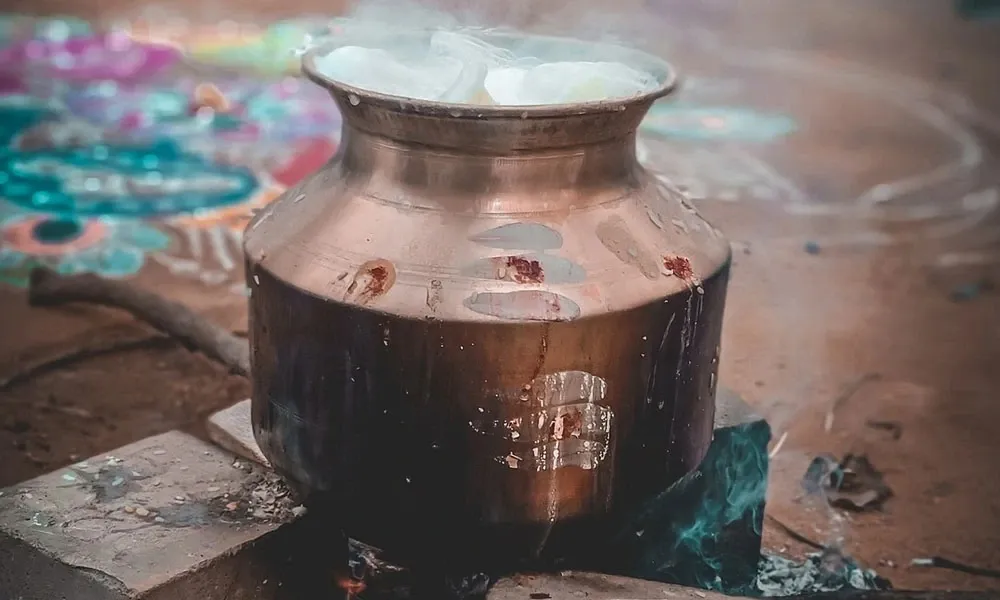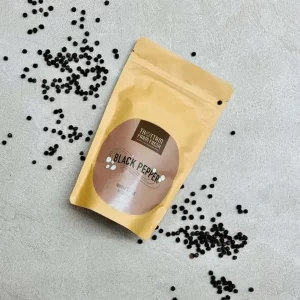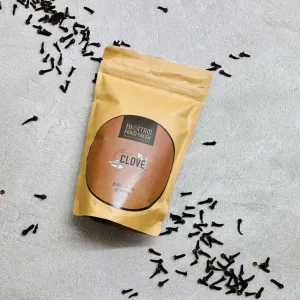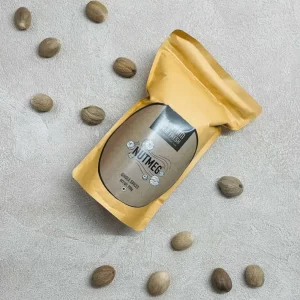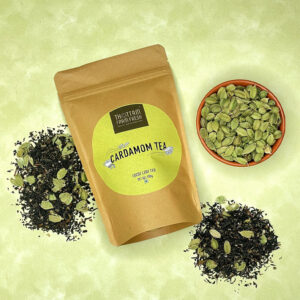Pongal offers:
10% OFF on all products – Use coupon code “Pongal10”
15% OFF on Turmeric Powder – Use coupon code “Pongal15”
India is a country known for its vibrant culture and diverse traditions. Festivals are an important part of this culture, offering an opportunity to celebrate the traditional customs and values that have been passed down through generations. Pongal is one such special festival celebrated widely in India.
Pongal is a four-day Hindu festival celebrated largely in South India, more precisely in the Indian states of Tamil Nadu and Puducherry. This popular harvest festival marks the transition from winter to spring with joyous prayers and offerings to the sun god. It is celebrated to thank the sun god, mother nature, and animals for the fulfilling harvest. It is believed that this ritual brings prosperity to households, wealth and good health to all.
The celebration of Pongal includes many traditional activities like decorating homes with colourful kolams (rangoli designs), preparing Pongal (a sweet rice dish) as an offering for gods, wearing new clothes and visiting family members and friends. Families gather together in their best attire for special poojas or religious ceremonies at home or in temples, where they offer thanksgiving to the sun god for a successful harvest season. Prayers are accompanied by traditional music and dance performances, creating a festive atmosphere wherever it is held.
Spicing Up the Celebrations
Indian spices have been a part of the culture for centuries and are used in many traditional dishes. Spices play a big role in Indian cuisine and are integral to many festive dishes. From adding cumin and peppercorn to savoury dishes to cardamom in desserts, spices can take an ordinary dish and make it extraordinary. Always buy spices in small quantities and use them fresh.
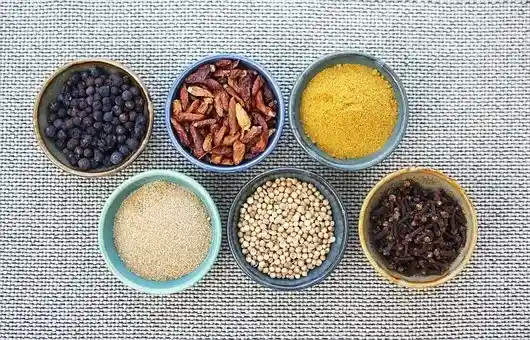
Using Indian spices adds flavour, aroma and colour to dishes, making them even more special. Many Indian spices such as cumin, turmeric, cardamom, ginger and saffron are used in various recipes including savoury dishes. Aromatic cardamom pods are also ground into powder to make scrumptious desserts like rice kheer or gulab jamun. Other popular spices include cloves, cinnamon sticks, bay leaves and red chilli powder that can add zest to any dish.
As the festival of Pongal is all about getting together with family and friends, it would not be a proper celebration without the addition of spices. Spices are essential in most dishes served during the festival, giving them unique and complex flavours. Adding Indian spices to Pongal transforms them into delightful culinary delights that everyone loves.
For added flavour, fresh herbs such as curry leaves or coriander leaves can also be used. These fragrant herbs add an extra layer of complexity to many traditional Pongal recipes like Pongal (rice pudding). Furthermore, adding a handful of nuts like cashews or almonds can create a crunchy texture that pairs well with warm spices like cinnamon and cloves.
Delicious Pongal Recipe
Pongal is an incredibly delicious and nutritious meal that is perfect for breakfast, lunch, or dinner. It consists of a mixture of rice and lentils that has been cooked with spices, herbs, and other ingredients. There are two types of Pongal – the Ven Pongal or savoury Pongal and other is the Sakkarai Pongal, the sweet one.
The ingredients for the Pongal variations are almost similar. You require:
- ½ cup of Rice
- ¼ cup of Moong Lentil or Dal
- Ghee
- Curry leaves
- Mustard Seeds
- Water
- Cashew
- Salt (for savoury Pongal)
- Jaggery (For sweet Pongal)
Recipe
Ven or Savoury Pongal
Step 1: Add the moong dal to a pan to roast them until it gets golden in colour
Step 2: Take the roasted moong dal and add rice (make sure you take good quality rice or grained white rice for appropriate texture)
Step 3: Rinse the rice and lentils properly several times with clean water
Step 4: Drain all the water and put both in a pressure cooker
Step 5: Now add ½ a teaspoon of cumin (jeera) seeds, 1/8 teaspoon of Hing (asafoetida), and 1 teaspoon of chopped ginger (adrak). You may also crush the cumin seeds a little for adding aroma and distinctive flavour
Step 6: Add 3- 4 cups of water depending on what kind of consistency you need
Step 7: Wait for 8-9 whistles.
Step 8: After the cooker is cooled down, open the lid to find a porridge (khichdi) like consistency
Step 9: If you find the rice and dal are not properly dissolved, you may add more water and mix them well in an open cooker to get the consistency.
Step 10: Now prepare the seasoning for Ven Pongal
Step 11: Take another pan and add 3-4 tablespoons of ghee
Step 12: Once the ghee is a little hot, add 1 teaspoon of cumin seeds and wait till it gets roasted
Step 13: Add 12-14 cashew pieces and fry till it becomes golden
Step 14: Add 10-12 curry leaves and 1 teaspoon of black pepper
Step 15: Stir well and fry them until crisp.
Step 16: Now pour the seasoning into the Pongal and mix well
Step 17: Cover the Pongal and leave it for 7-10 mins so that the seasoning can infuse well with the Pongal.
Now, serve the hot Pongal to your guests. You can even add mango pickle or curd on the side. Another best combo is Pongal and Sambhar. If you wish to enjoy savoury Pongal, relish this recipe with your guests.
Sweet or Sakkarai Pongal
Sweet Pongal has long been an essential part of the Pongal traditions for its delicious taste and symbolic meaning. The dish is traditionally prepared in large quantities to mark the beginning of the harvest season and share with family, friends and neighbours.
It is made from rice, mung dal, water, and ghee, the same ingredients as savouring Pongal, with the only addition of jaggery. This delicious sweet dish has a rich flavour and an inviting aroma that will make your mouth water.
Recipe:
Step 1: Add the moong dal to a pan to roast them until it gets aromatic
Step 2: Take the roasted moong dal and add rice (make sure you take good quality rice or grained white rice for appropriate texture)
Step 3: Rinse the rice and lentils properly several times with clean water
Step 4: Drain all the water and put both in a pressure cooker
Step 5: Add 3- 4 cups of water depending on what kind of consistency you need
Step 6: Wait for 8-9 whistles.
Step 7: After the cooker is cooled down, open the lid to find a porridge (khichdi) like consistency
Step 9: If the rice and dal are not properly dissolved, add more water and mash them well in an open cooker to get the consistency. As the Pongal is getting prepared-
- Mince 5 cardamom seeds and 1 clove to add it further. If using cardamom powder then you can simply use ½ teaspoon.
Step 10: Now prepare the Jaggery Syrup for Sakkarai Pongal
- Cut or grate 120 gms of jaggery into small pieces to get almost ½ cup of jaggery, if you want more sweetness, add more jaggery
- Now take ½ cup of water and add the jaggery to it.
- Heat the jaggery in a low flame until it melts completely to a proper solution. Use a spoon to break the pieces or chunks into proper ration
- Keep stirring and heat it till the syrup gets dark.
- Once done, strain the jaggery and sieve it to add it to Pongal porridge.
Step 11: Now add the crushed cardamom and clove to the porridge and jaggery syrup,
Step 12: Mix it well, and leave it to cool. The Sakkarai Pongal will thicken as it gets cool down. If you find it extra thick, you may mix some hot water to reduce the thickness.
Prepare the seasoning:
Step 13: Take a pan and add 12-14 cashew pieces and fry till it becomes golden
Step 14: Add some raisins to it.
Step 15: Stir well and fry them until the raisins become pulpy and thick.
Step 16: Now pour the seasoning into the sweet Pongal and mix well
Step 17: Cover the Pongal and leave it for 7-10 mins so that the seasoning can add the taste to the Pongal.
You can offer the sweet Pongal to the Gods and then share the sumptuous meal with your friends and family after prayers.
However, when preparing the dish there are many variations to Pongal you can add peanuts to make it crunchy, or add sugar and milk to make it creamier. If you do not wish to go through the lengthy process, you can use the recipe and make it quickly in a pot in an instant pot.
Health Benefits of Pongal dish
Pongal is a dish that tastes delicious, and also offers many health benefits. The combination of ingredients in Pongal provides an array of essential vitamins and minerals for optimal health and wellness. Rice provides complex carbohydrates to maintain energy levels throughout the day. Lentils are a great source of plant-based protein which helps build muscle mass and aids in weight loss efforts. The aromatic spices used in the recipe offer anti-inflammatory properties to reduce joint swelling and soreness after physical activity. Plus, these spices also help aid digestion by increasing stomach acid production for better absorption of nutrients from food intake.
The ingredients used to make Sweet Pongal have many health benefits. Rice provides carbohydrates for energy while mung dal supplies essential vitamins and minerals to the body. Jaggery gives the dessert its sweet taste but also contains iron and several other micronutrients beneficial for our health.
Thus, Pongal is a beautiful festival that celebrates the harvest season and brings people together. It is an opportunity to honour the Sun God for providing an abundant crop and to celebrate traditional Indian culture with food, music, and dance. Celebrating Pongal with spices can be a fun way of bringing flavour to the festivities. Not only do spices add flavour to the dishes prepared for this joyous occasion, but they also have health benefits as well. Finally, adding a traditional Pongal recipe can make your celebration even more special by showcasing authentic Pongal cuisine.

